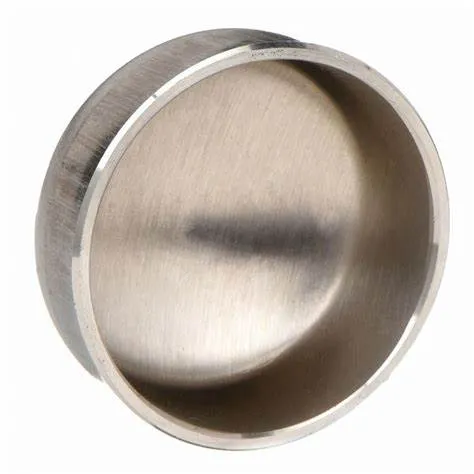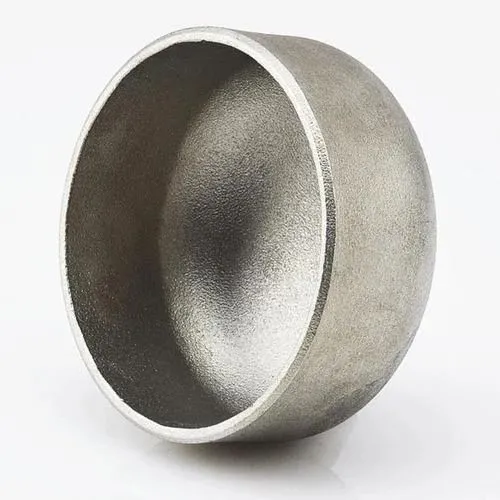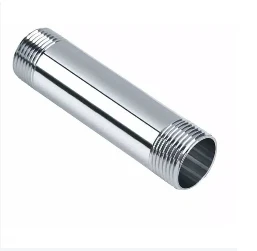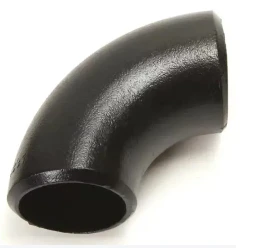JIS B2311 ialah Piawaian Perindustrian Jepun yang meliputi kelengkapan paip kimpalan punggung, termasuk penutup yang digunakan dalam sistem paip. Penutup kimpalan punggung berfungsi untuk menutup hujung paip, menyediakan pengedap untuk mengelakkan kebocoran atau pencemaran. Berikut ialah pengenalan kepada penutup kimpalan punggung JIS B2311:
- 1. JIS B2311 Standard:
- - Piawaian JIS B2311 menentukan keperluan untuk reka bentuk, dimensi, bahan, pembuatan dan ujian kelengkapan kimpalan punggung, termasuk penutup, dalam sistem paip.
- - Piawaian ini memastikan penutup yang dihasilkan mematuhi piawaian JIS memenuhi piawaian kualiti dan serasi dengan komponen paip lain.
- 2. Penutup Kimpalan Punggung:
- - Penutup kimpalan punggung, menurut JIS B2311, ialah pemasangan yang direka untuk menutup dan mengelak hujung paip dengan selamat, menawarkan perlindungan dan mengekalkan integriti sistem paip.
- - Penutup digunakan dalam situasi di mana hujung paip memerlukan penutupan, sama ada secara kekal atau sementara, untuk mengelakkan kebocoran, pencemaran, atau untuk memberikan kemasan kepada sistem.
- 3. Bahan dan Pembinaan:
- - Penutup kimpalan punggung di bawah spesifikasi JIS B2311 tersedia dalam pelbagai bahan seperti keluli karbon, keluli tahan karat dan keluli aloi untuk memenuhi keperluan aplikasi yang berbeza.
- - Penutup ini dihasilkan menggunakan kaedah pembinaan piawai untuk memastikan sambungan yang kuat dan bebas kebocoran apabila dikimpal ke hujung paip.
- 4. Permohonan dan Faedah:
- - Penutup kimpalan punggung menemui aplikasi dalam pelbagai industri, termasuk minyak dan gas, proses kimia, loji rawatan air dan banyak lagi di mana hujung paip perlu ditutup dengan selamat.
- - Penutup memberikan perlindungan kepada hujung paip daripada unsur persekitaran, mencegah pencemaran, dan membantu mengekalkan kebersihan dan integriti sistem paip.
- 5. Pemasangan dan Kimpalan:
- - Amalan pemasangan yang betul, termasuk penjajaran yang betul, penyediaan hujung paip, dan teknik kimpalan, adalah penting semasa memasang penutup kimpalan punggung untuk memastikan pengedap yang ketat dan kalis bocor.
- - Kimpalan ialah kaedah biasa untuk memasang penutup pada paip, menyediakan penutupan yang selamat dan kekal yang boleh menahan tekanan, variasi suhu dan aliran bendalir dalam sistem.
- Ringkasnya, penutup kimpalan punggung JIS B2311 ialah komponen penting yang digunakan dalam sistem perpaipan untuk mengelak dan melindungi hujung paip dengan selamat. Penutup ini mematuhi keperluan piawai untuk memastikan kualiti, kebolehpercayaan dan keserasian dalam aplikasi industri yang memerlukan penutupan dan perlindungan paip.
What Is a Butt Welding Cap and How Is It Used in Industrial Piping?
In industrial piping systems, end-of-line sealing and branch closures require robust solutions. A butt welding cap serves as a critical component for terminating pipes securely. By providing a seamless, welded closure, this fitting maintains system integrity, prevents leaks, and supports compliance with industry standards.
What Is a Butt Welding Cap?
A butt welding cap—also called a pipe end cap or buttweld end cap—is a round fitting designed to close off the end of a pipe. It’s manufactured to match the pipe’s outer diameter and schedule, with either a hemispherical or flat face. To install, both the pipe end and cap are beveled to form a V‑groove, enabling full‑penetration, fusion welds. Common materials include carbon steel, stainless steel, nickel alloys, and other engineered grades, chosen to satisfy pressure, temperature, and corrosion‑resistance requirements.
How Is Butt Welding Cap Used in Industrial Piping?
Butt welding caps find application across oil & gas, petrochemical, power generation, water treatment, and general process industries for both permanent and temporary closures. During hydrostatic testing, technicians install caps to seal off sections of piping while monitoring for leaks. In new construction or retrofit projects, caps terminate branch lines, future tie‑in spools, or dead‑end mains until system expansion. Welders prepare each joint by cleaning and beveling surfaces, aligning the cap precisely, and executing a root pass followed by filler passes per the qualified Welding Procedure Specification (WPS). Post‑weld heat treatment and non‑destructive examination (NDE)—such as radiography or ultrasonic testing—verify weld integrity and compliance with ASME B16.9 and related standards. Additionally, temporary caps enable safe isolation during maintenance, allowing for segment testing and dewatering under regulatory protocols.
Benefits and Best Practices
Butt welding caps offer a smooth‑bore transition that minimizes flow disruption and stress concentration. Their full‑penetration welds deliver exceptional structural strength and leak resistance. To optimize performance, engineers should:
Select caps with matching material grades and wall thicknesses
Adhere to proper bevel angles and joint fit‑up tolerances
Follow qualified WPS protocols rigorously
Consider cladding or protective coatings in corrosive environments to extend service life
Regular inspection and thorough documentation ensure long‑term reliability and safe operation under demanding conditions.
Butt welding caps are indispensable components for achieving durable, leak‑proof pipe terminations in a wide range of industrial applications.
Butt Welding Cap FAQs
What is a butt welding cap?
|
What materials are commonly used?
|
What standards govern butt welding caps?
|
How are butt welding caps installed?
|
Where are butt welding caps typically used?
|
What are the advantages of threaded caps?
|
















